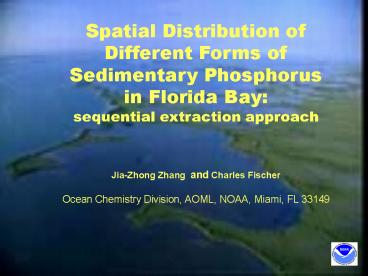Spatial Distribution of PowerPoint PPT Presentation
Title: Spatial Distribution of
1
Spatial Distribution of Different Forms of
Sedimentary Phosphorus in Florida Bay
sequential extraction approach Jia-Zhong
Zhang and Charles Fischer Ocean Chemistry
Division, AOML, NOAA, Miami, FL 33149
2
Florida Bay
3
Bottom type
4
Low phosphate concentration in Florida Bay
water Zhang Chi, 2002
5
Sediment sampling station
6
Sequential extraction procedure
7
Percentage of CaCO3 in Florida Bay sediments
8
Total Sedimentary Phosphorus in Florida Bay
9
Total exchangeable phosphorus by MgCl2 extraction
10
Exchangeable Inorganic phosphorus by MgCl2
extraction
11
Exchangeable organic phosphorus by MgCl2
extraction
12
Iron-bound Phosphorus by dithionite extraction
13
Reactive iron in Florida Bay sediments
14
Salinity of Florida Bay water during sediment
sampling By courtesy of Lee John
15
CaCO3-bound total phosphorus by HAc (pH 4)
extraction
16
CaCO3-bound inorganic phosphorus
17
CaCO3-bound organic phosphorus
18
Detrital phosphorus by HCl extraction
19
Residual refractory organic phosphorus by ashing
20
comparison
21
(No Transcript)
22
Percentage of Different Forms of Sedimentary
Phosphorus
23
Summary
- Strong W-E spatial gradient in TSP and every
forms of sedimentary P - CaCO3-bound P accounts 44 of TSP
- Refractory organic P constitutes 24 of TSP
- Iron-bound P accounts 19 of TSP
- Exchangeable P accounts 8 of TSP
24
Sunset
Recent Publications
Zhang, Jia-Zhong, Charles J. Fischer, and Peter
B. Ortner, (2004) Potential availability of
sedimentary phosphorus to sediment resuspension
in Florida Bay, Global Biogeochemical Cycles. 18,
GB4008, doi 10.1029/2004GB002255, 2004. Zhang,
J.-Z., J. Chi (2002) Automated analysis of
nanomolar concentrations of phosphate in natural
waters with liquid waveguide, Environmental
Science Technology, 36(5) 1048-1053.
Acknowledgements
This research was supported by NOAAs South
Florida Ecosystem Restoration, Prediction and
Modeling Program
PowerShow.com is a leading presentation sharing website. It has millions of presentations already uploaded and available with 1,000s more being uploaded by its users every day. Whatever your area of interest, here you’ll be able to find and view presentations you’ll love and possibly download. And, best of all, it is completely free and easy to use.
You might even have a presentation you’d like to share with others. If so, just upload it to PowerShow.com. We’ll convert it to an HTML5 slideshow that includes all the media types you’ve already added: audio, video, music, pictures, animations and transition effects. Then you can share it with your target audience as well as PowerShow.com’s millions of monthly visitors. And, again, it’s all free.
About the Developers
PowerShow.com is brought to you by CrystalGraphics, the award-winning developer and market-leading publisher of rich-media enhancement products for presentations. Our product offerings include millions of PowerPoint templates, diagrams, animated 3D characters and more.

